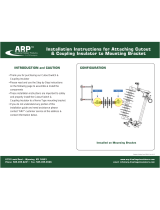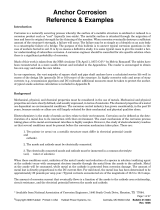Page is loading ...

®
®
POWER SYSTEMS, INC.
Instructions for Installation, Operation and Maintenance
of A.B. Chance Company Type C Loadbreak Porcelain and Polymer Cutout
GENERAL
The A. B. Chance Type C Loadbreak Cutout is for protection of
equipment only. It DOES NOT protect personnel from injury or
electrocution if contact with energized circuits or hardware occurs.
© 2002 Hubbell / Chance, 210 N. Allen St., Centralia, MO 65240
The equipment covered by this instruction guide should be selected,
installed and serviced by competent personnel who understand
proper safety procedures. This instruction guide is written for such
personnel and is not a substitute for adequate training and experience
in safety procedures regarding this type of equipment.
The A. B. Chance Company Type C Loadbreak Cutout is an expulsion
type distribution fuse. Its primary functions are to interrupt fault or
overload current within its rating on a distribution line to protect the
electric circuit and/or connected equipment and to provide a loadbreaking
capability to intentionally isolate connected equipment.
ANSI Standard C37.48 prescribes guidelines for application, operating
and maintenance of distribution cutouts and shall be followed in addition
to this instruction guide.
NOTE: Because Hubbell has a policy of continuous product
improvement, we reserve the right to change design and specifications
without notice.
Figure 1
P730-0030 Rev. D
!
DANGER
INSTALLATION
Mount the cutout on the mounting bracket with the external tooth
lockwasher placed between the mounting bracket and the cutout
bushing support pin (see Figure 1). Tighten the nut finger tight.
Rotate the cutout on the mounting bracket to provide maximum
clearance for the operator and vented ends which expel hot gases
and high velocity particles during interruption and to provide
maximum ease of operation. Securely tighten carriage bolt nut.
NOTE: A properly sized cutout must be selected for each
installation with consideration to recovery voltage, continuous
current, BIL and fault interrupting rating. Should there be any
concern regarding use of this cutout as rated, consult your
supervisor before installation.
Securely attach mounting bracket if supplied with cutout, to
crossarm or pole.
DO NOT mount this cutout in vaults or other enclosed areas because
of the expulsion emitted during current interruption.
!
CAUTION
!
WARNING
To attach electrical leads, first loosen top and bottom terminal washer
faced nuts. Wire brush conductors and apply a coating of oxidation
inhibitor before inserting conductor into terminal. Tighten washer faced
nuts to approximately 20 ft./lb.
To install the fuselink in the fuseholder, remove the cap from the upper
ferrule of the fuseholder assembly. Slide the fuselink, cable end first, into
the top of the fuseholder and pull out at the lower end.
!
CAUTION
Replace the cap on the upper fuseholder ferrule and tighten with a
wrench. Holding the fuseholder at the lower end, rotate the link ejector
about its pivot until it stops, making certain that the tab on the link ejector
engages the latch on the lower fuseholder ferrule. (See Figure 2.). Holding
the ejector in this position, feed the cable over the link ejector channel and
around the thread stud in a clockwise direction. (See Figure 3.) Maintaining
tension on the fuselink cable, tighten the fuselink attachment nut with a
wrench. Clip excess fuselink cable.
Do not replace arc shortening rod with a standard cap. the rod is
required to achieve the designated interrupting rating and use of the
cutout without the rod will reduce the cutout’s interrupting capability
and may cause the cutout to fail to interrupt.
Do not use 100 amp or smaller fuselinks in 200 amp fuseholders by
employing washers or other means. This could result in the cutout
to fail to interrupt.
NOTE: Cutouts using an arc shortening rod require the
use of removable buttonhead fuselinks. To attach the
fuselink to the arc shortening rod, remove the screw-type
buttonhead (and washer if equipped) from the fuselink.
Screw the arc shortening rod (attached to cap) onto the
fuselink and tighten firmly. (See Figure 4.) Follow same
procedure as outlined in above paragraph.
!
CAUTION
Do not remove or damage the small tube on the fuselink. It is an
integral part of the fuselink and removal or damage may result in the
cutout’s failure to interrupt.
Tab
Latch
Figure
3
Figure
2
Figure
4
Arc
Shortening
Rod
Fuse Link
!
CAUTION
Note: Some fuselinks have removable button heads. If this type of
link is used on cutouts not equipped with an arc shortening rod,
tighten the button head firmly before installing the fuselink in the
fuseholder

OPERATION
After positioning himself well clear from the vented end and exhaust path
of the cutout, the operator should place the disconnect stick in the ring on
the upper ferrule of the fuseholder. Rotate the fuseholder to an intermediate
position as in Figure 6. Look away from the cutout. Quickly and firmly
drive the fuseholder into the closed position. Remove disconnect stick
from the ring carefully to avoid opening the fuseholder.
Hot gases and high velocity particles are expelled from fuseholder
during interruption. This expulsion can cause serious injury. Stay
away from conical area below and in-line with fuseholder.
Once the fuselink has been installed in the fuseholder, insert the disconnect
stick into the opening in the fuseholder trunnion. Place the fuseholder
into the hinge as shown in Figure 5. Remove the disconnect stick.
Only qualified personnel should operate a cutout. Such personnel
should wear appropriate protective equipment such as rubber gloves,
hard hats, safety glasses, etc., in accordance with established utility
and safety practices
Use only approved A. B. Chance Co. loadbreak fuseholders. This
fuseholder has a trip lever attached for loadbreaking purposes. Use
of any other fuseholder eliminates any loadbreak capability, and may
result in property damage or personal injury
Figure
6
!
CAUTION
!
WARNING
!
CAUTION
Figure
5
All Type “C” Loadbreak Cutouts are equipped with an arc chute type
interrupter. The arc chute enables the cutout to perform as a loadbreak
Hot gases and particles are expelled from the arc chute during
opening. These can cause personal injury. Look away and
position yourself to the side of the arc chute when opening.
After opening fuseholder, swing it into a full open position. Use a
disconnect stick to remove the fuseholder from the cutout hinge as
shown in Figure 7b.
!
WARNING
Figure
7a
Figure
7b
These instructions do not claim to cover all details or variations in equipment, nor to provide for all possible conditions to be met with concerning
installation, operation, or maintenance of this equipment. If further information is desired or if particular problems are encountered which are not
sufficiently covered in this guide, contact A. B. Chance Company.
MAINTENANCE
Refer to ANSI Standard C37.48 as a general guide. Periodically inspect the
fuselink at the lower open end of the fuseholder for evidence of corrosion.
Replace fuselinks which show signs of deterioration (broken strands,
heavy corrosion, etc.). Replace broken/ cracked porcelain or torn polymer
insulator and clean or replace if heavily contaminated. Inspect contacts
for excessive pitting or burning and replace as necessary. Check the
fuseholder fiber liner for cracking or excessive erosion. If cracked or if the
I.D. is larger than .650 inches and.860 inches on the 100 and 200 amp
© 2002 Hubbell / A. B. Chance Co., 210 N. Allen St., Centralia, MO 65240
P730-0030 Rev. D
2
NOTE: Porcelain insulator
shown, also applies to
Polymer insulator.
NOTE: Porcelain insulator shown,
also applies to Polymer insulator.
®
®
POWER SYSTEMS, INC.
Store fuse holder in an upright position out-doors or in a
non-heated weather protected area. Excessive water enter-
ing the bore of the fuse holder may cause interior corro-
sion, damage the fuse holder liner or damage the fuse link.
These conditions may cause the fuse to fail to interrupt an
over-current.
!
CAUTION
device capable of interupting load currents. Refer to the catalog number
for information regarding specific loadbreaking capability.
To operate this loadbreak device place a disconnect stick in the pull ring
on the fuseholder as shown in Figure 7a. Position yourself slightly to one
side of the cutout, about two feet to one side, look away from the cutout and
pull sharply on the disconnect stick without hesitation.
fuseholders respectively, then replace the fuseholders. If the fuseholder
shows any signs of electrical tracking it should be replaced.
Check the trip lever on the fuseholder for burrs or excessive erosion.
Replace fuseholder if necessary. Check arc chute for cracks and replace if
broken. On lines not energized, operate the trip lever by completely
opening and closing the device to check for smooth operation and replace
if necessary.
/



